TestedTwice
New member
So I am picking up my very first revolver this week! I purchased a six-inch Smith and Wesson 686 and am quite excited! Since this is my first revolver, I had a few questions that I can't find by doing a Google search (likely because I don't know how to word them in six words or less for a search engine). These questions may or may not be stupid and pointless, but are still things I wonder. Haha.
1. Say I close the cylinder on my gun, but need to rotate it to lock in in place. Will it hurt any of the parts if I rotate the cylinder the opposite way it's supposed to go?
2. Say I cock the hammer, but want to lower it without dry-firing my gun. I'm perfectly fine with dry-firing my centerfire firearms, but I still want to know what I can and can't do. Will it cause any damage to my firearm if I brace the hammer with my thumb, pull the trigger to release the hammer, release the trigger, and let the hammer fall against the.... transfer bar? Hammer block? Or should I gently ride the hammer forward?
3. This question pertains specifically to Smith and Wesson revolvers and their silly internal locks. I know this may have been answered several times on this forum, but I have heard that Smith and Wesson may have corrected this with a stronger spring and I'm not sure what that time frame for that may be. Has anybody with a relatively new Smith revolver ever had an issue with the lock engaging by itself while shooting? I'm a little concerned about this.
I appreciate any answers to these questions, and apologize for any eye-rolling you may do. Lol.
1. Say I close the cylinder on my gun, but need to rotate it to lock in in place. Will it hurt any of the parts if I rotate the cylinder the opposite way it's supposed to go?
2. Say I cock the hammer, but want to lower it without dry-firing my gun. I'm perfectly fine with dry-firing my centerfire firearms, but I still want to know what I can and can't do. Will it cause any damage to my firearm if I brace the hammer with my thumb, pull the trigger to release the hammer, release the trigger, and let the hammer fall against the.... transfer bar? Hammer block? Or should I gently ride the hammer forward?
3. This question pertains specifically to Smith and Wesson revolvers and their silly internal locks. I know this may have been answered several times on this forum, but I have heard that Smith and Wesson may have corrected this with a stronger spring and I'm not sure what that time frame for that may be. Has anybody with a relatively new Smith revolver ever had an issue with the lock engaging by itself while shooting? I'm a little concerned about this.
I appreciate any answers to these questions, and apologize for any eye-rolling you may do. Lol.

